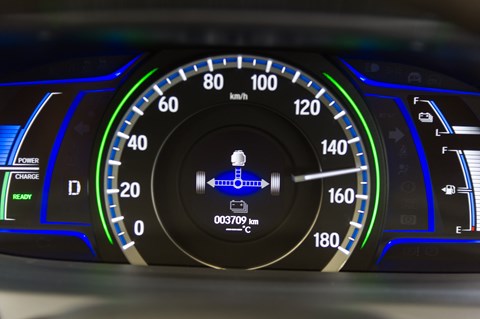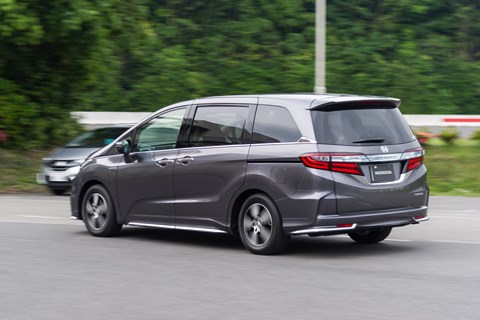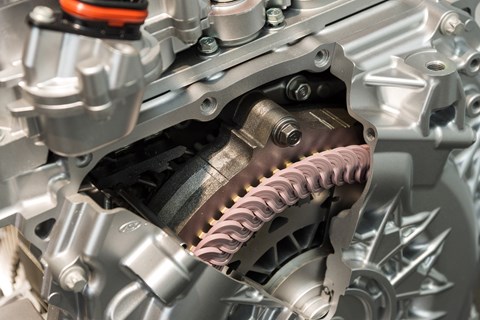► Honda’s latest two-motor hybrid system
► Tested on JDM Odyssey at Tochigi
► UK debut in 2018 in the next CR-V
Considering it was right at the sharp end of hybrid development in the 1990s, Honda seems to have dropped off the pace in terms of what you can buy in the UK.
Remember the Insight Mk1? It’s probably the coolest of all affordable hybrids, and when you could buy one new, it made the first-generation Toyota Prius it was up against look like an undesirable pudding.
Since then, Honda lost its hybrid mojo. The Civic IMA from the mid-2000s was a staid-looking US-market saloon that was blown into the weeds by its diesel-powered European-engineered turbodiesel sister car, while its replacement, the second-generation Insight was a pale imitation of a Prius. The CR-Z was cool to look at but not as sporting as its looks implied.
Today, Honda only offers one hybrid in the UK: the NSX. And although it’s rather nice, it’s hardly breaking down barriers in the mass market sector. Honda says this is all about to change in 2018.

So, go on then: what is i-MMD?
It’s Honda’s next-generation hybrid system, and it’s coming soon to a showroom near you.
The two-motor i-MMD system will be found under the bonnet of an unspecified new car.
For simplicity’s sake, let’s call that the new CR-V, which makes its European debut at the 2017 Frankfurt motor show. But you can buy an i-MMD car in Japan right now – either as the Odyssey MPV or Accord saloon, neither of which are sold in the UK.
i-MMD stands for Intelligent Multi Mode Drive, and all you need to know is that it’s a compact hybrid drivetrain that does away with conventional transmission system. Instead, electric motor and the 2.0-litre Atkinson-cycle petrol engine are linked by four gearsets, which use a single fixed gear ratio to transfer power to the driven wheels.
As with all decent hybrids these days, you can drive it in EV mode, as a conventional hybrid, or engine-only. EV and Hybrid are what you’d expect, relying on the batteries, engine, or a combination of both to drive the wheels. In this mode, the 2.0-litre hybrid punches out 209bhp. In Engine Drive mode, the engine drives the wheels directly, with additional hybrid electrical boost channelled in, should there be a demand.
A Power Control Unit (PCU) is used to shift between these three driving modes. Honda says this is a more efficient hybrid than rival systems – and because it has dropped the conventional transmission, it’s more compact, and light, too. Other than the battery pack, the entire hybrid drive system fits in a standard car engine bay.

That’s the tech, what’s it like to drive?
We’ll discount the Odyssey driving impressions – instead, let’s concentrate on how the hybrid system works. And on that score in Hybrid Drive mode, it’s pretty standard stuff.
Stick it in D, enjoy a silent step-off, and as long as you’re not too heavy on the throttle, it’ll accelerate reasonably quickly and smoothly without kicking in the petrol motor.
It feels like any other hybrid to drive, really. Where this car gains in efficiency, and where you can feel it when you drive is the way in which the petrol engine is completely disengaged from the drive wheels when in EV mode.
This reduced friction and drag in the system, and means the i-MMD has a mere 30bhp drop-off between the motor and the drive wheels. Maximum power output is 209bhp – which should be useful enough in a CR-V-sized package. Honda has yet to quote official mpg figures for it, but on our test route, it’s averaging 60mpg.

When the petrol engine does kick in, you’ll be hard pushed to tell. Of course, when you floor it, you do get a tinny, CVT-like buzz from the petrol engine, but it feels as refined, if not more so, than a Toyota Prius. At higher speeds, it engages Engine Drive mode, which effectively provides direct drive to the front wheels via a lock-up clutch.
On Honda’s Tochigi test track, which has spookily smooth road surfaces, you struggle to hear the transition from battery, via series hybrid to petrol in normal driving. This implies it’ll be impressively refined when it does come to the UK.
Verdict – and why we should care
Why indeed. Honda’s future lies away from diesel cars. And that’s why when its big-selling CR-V comes to the UK, you’ll be able to buy it in hybrid form. Despite the impressive refinement of the i-DTEC turbodiesel in the current CR-V, you’ll never, ever forget it’s fuelled from the black pump.
The new hybrid will turn that on its head. If it delivers the refinement and efficiency hinted at on Honda’s test track, it’ll help do its bit to convince drivers away from diesel. Honda says its committed to building a diesel version of the next CR-V, but probably not the one after that. Driving this Odyssey shows hybrid drive will be at least be a very refined, if not necessarily exciting, affair.